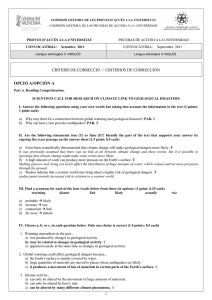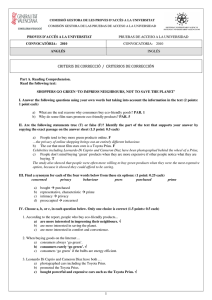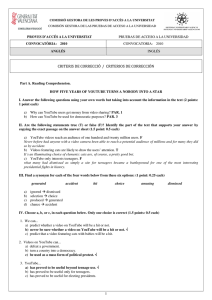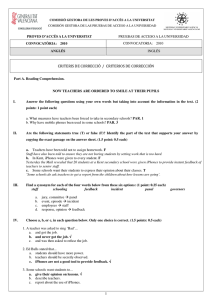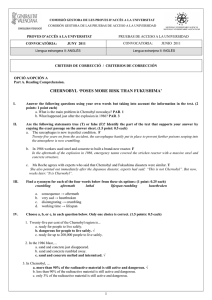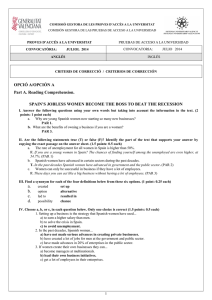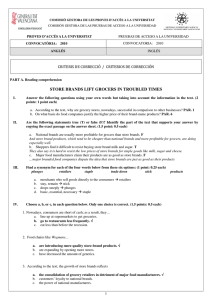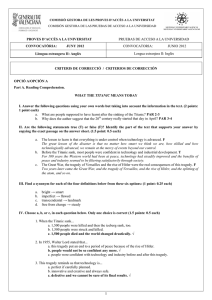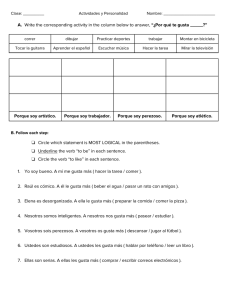OPCIÓ A/OPCIÓN A Part A. Reading Comprehension
Anuncio
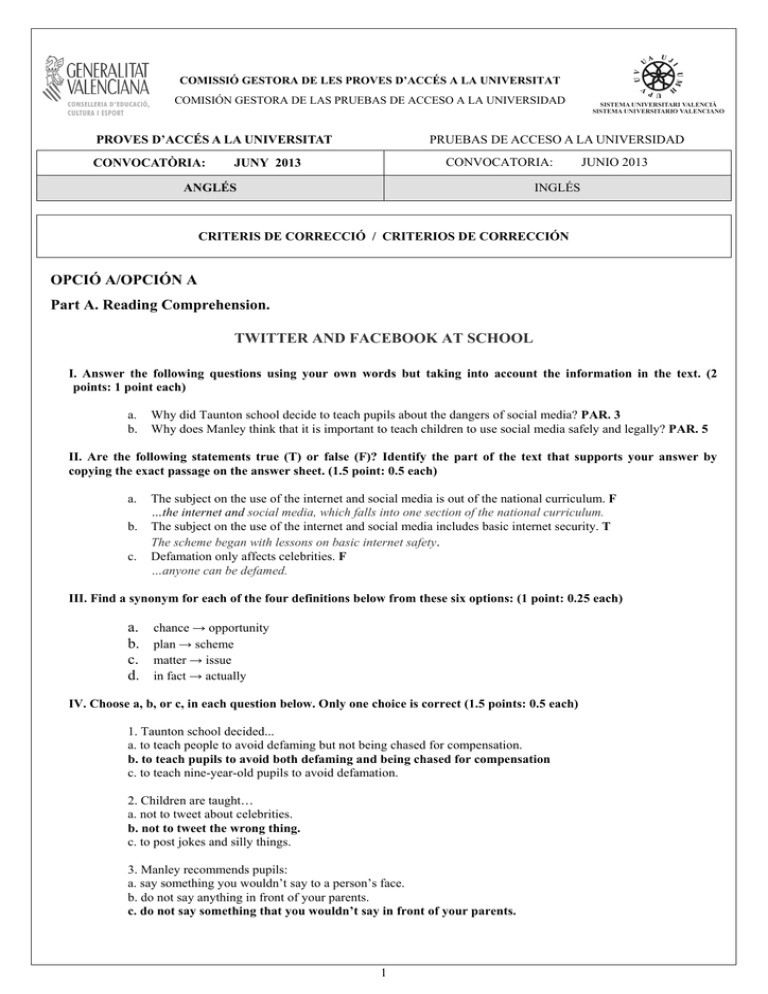
COMISSIÓ GESTORA DE LES PROVES D’ACCÉS A LA UNIVERSITAT COMISIÓN GESTORA DE LAS PRUEBAS DE ACCESO A LA UNIVERSIDAD PROVES D’ACCÉS A LA UNIVERSITAT CONVOCATÒRIA: PRUEBAS DE ACCESO A LA UNIVERSIDAD CONVOCATORIA: JUNY 2013 JUNIO 2013 INGLÉS ANGLÉS CRITERIS DE CORRECCIÓ / CRITERIOS DE CORRECCIÓN OPCIÓ A/OPCIÓN A Part A. Reading Comprehension. TWITTER AND FACEBOOK AT SCHOOL I. Answer the following questions using your own words but taking into account the information in the text. (2 points: 1 point each) a. b. Why did Taunton school decide to teach pupils about the dangers of social media? PAR. 3 Why does Manley think that it is important to teach children to use social media safely and legally? PAR. 5 II. Are the following statements true (T) or false (F)? Identify the part of the text that supports your answer by copying the exact passage on the answer sheet. (1.5 point: 0.5 each) a. b. c. The subject on the use of the internet and social media is out of the national curriculum. F …the internet and social media, which falls into one section of the national curriculum. The subject on the use of the internet and social media includes basic internet security. T The scheme began with lessons on basic internet safety. Defamation only affects celebrities. F …anyone can be defamed. III. Find a synonym for each of the four definitions below from these six options: (1 point: 0.25 each) a. b. c. d. chance → opportunity plan → scheme matter → issue in fact → actually IV. Choose a, b, or c, in each question below. Only one choice is correct (1.5 points: 0.5 each) 1. Taunton school decided... a. to teach people to avoid defaming but not being chased for compensation. b. to teach pupils to avoid both defaming and being chased for compensation c. to teach nine-year-old pupils to avoid defamation. 2. Children are taught… a. not to tweet about celebrities. b. not to tweet the wrong thing. c. to post jokes and silly things. 3. Manley recommends pupils: a. say something you wouldn’t say to a person’s face. b. do not say anything in front of your parents. c. do not say something that you wouldn’t say in front of your parents. 1 COMISSIÓ GESTORA DE LES PROVES D’ACCÉS A LA UNIVERSITAT COMISIÓN GESTORA DE LAS PRUEBAS DE ACCESO A LA UNIVERSIDAD PROVES D’ACCÉS A LA UNIVERSITAT CONVOCATÒRIA: PRUEBAS DE ACCESO A LA UNIVERSIDAD CONVOCATORIA: JUNY 2013 JUNIO 2013 INGLÉS ANGLÉS CRITERIS DE CORRECCIÓ / CRITERIOS DE CORRECCIÓN OPCIÓ B/OPCIÓN B TEEN SPIRIT: WHAT’S IT REALLY LIKE TO BE A TEENAGER? I. Answer the following questions using your own words but taking into account the information in the text. (2 points: 1 point each) a. b. Why do teenagers behave the way they do? PAR. 3 Why was the book Teenagers Explained published? PAR. 4 II. Are the following statements true (T) or false (F)? Identify the part of the text that supports your answer by copying the exact passage on the answer sheet. (1.5 point: 0.5 each) a. The mind, not hormones, causes teenage behaviour. F First we blamed hormones. Then scientists found that the human mind undergoes a massive restructuring during the 12th to 25th years. b. Teenage behaviour is closely related to how the brain develops. T These result in behaviours that parents might have thought were designed to cause them pain, but which are in fact vital processes in the brain’s development. Scientific discoveries have helped parents get on with their sons and daughters. F The truth remains that science offers a rational explanation, but it doesn’t make everyday communication with teenagers any easier. c. III. Find a synonym for each of the four definitions below from these six options: (1 point: 0.25 each) a. b. c. d. shift → transition worried → concerned puzzled → baffled huge → massive IV. Choose a, b, or c, in each question below. Only one choice is correct (1.5 points: 0.5 each) 1. Teenagers’ behaviour... a. causes an acceleration of a massive restructuring of the mind. b. causes a massive restructuring of their minds. c. is caused by a massive restructuring of their minds. 2. Science… a. has really helped parents communicate with their teenage sons and daughters. b. has not really helped parents communicate with their teenage sons and daughters. c. has really helped teenagers communicate with their teenage friends. 3. Lovegrove... a. thinks that parents’ concern and questions are understandable. b. thinks that parents’ concern and questions are unnecessary. c. thinks that parents’ concern and questions will make teenagers explode. 2 Part B. Producció escrita. Valor total d'aquesta part 4 punts. En aquesta part es demana que els alumnes produeisquen un text de 130-150 paraules. En aquest apartat s'ha de valorar la capacitat de comunicació de l'alumne en un anglès acceptable en expressar la seua opinió i idees sobre aspectes relacionats amb el text proposat. Caldrà valorar quant de positiu haja pogut portar a terme l'alumne i no fixar-se únicament en els errors gramaticals. Seria fonamental considerar els següents aspectes: 1. Aspectes de caràcter estratègic: amb un màxim de 0,5 punts. 2. Correcció gramatical: amb un màxim de 1,5 punts. 3. Claredat d'expressió i organització textual: amb un màxim d'1 punt. 4. Varietat, riquesa i precisió lèxica: amb un màxim d'1 punt. ORIENTACIONS PER A CORRECCIÓ DELS ASPECTES ANTERIORS 1. Aspectes de caràcter estratègic: - Presentació clara i ordenada (marges, sagnats, etc.). - Ortografia correcta. - Text distribuït en paràgrafs. - Ús correcte de signes de puntuació. - Lletra clara i comprensible. - Escrit en tinta. -… 2. Correcció gramatical: - Ordre correcte dels elements fràstics (SVO…). - Concordances correctes (S-V, pronoms referents…). - Formes pronominals correctes. - Quantificadors correctes. - Estructuració negativa correcta. - Temps i seqüències verbals adequats i correctes. - Partícules temporals adequades (FOR, SINCE, AGO, ALREADY). - Ús adequat d'articles (genèrics, específics…). - Ús correcte del possessiu. - Coneixement dels plurals irregulars. - Ús correcte de modals i defectius. - Invariabilitat dels adjectius (gènere i nombre). - Ús correcte de les preposicions. -… 3. Claredat d'expressió i organització textual: - Seqüenciació i organització del text clara i lògica. - No hi ha excessives repeticions. - No és un text confús i fosc. - Ús adequat de connectors per a les diferents idees. - Aproximació al tema coherent i original. - Estructuració de les idees en paràgrafs. -… 4. Varietat, riquesa i precisió lèxica: - No s'usen paraules en espanyol ni inexistents. - Elecció de termes específics i concrets per a aqueix text. - No existeix confusió entre elements lèxics bàsics. - No hi ha confusió entre categories gramaticals. - No existeix un abús desmesurat d'expressions idiomàtiques. 3 Parte B. Producción escrita. Valor total de este apartado 4 puntos. En esta parte se pide que los alumnos produzcan un texto de 130-150 palabras. En este apartado se ha de valorar la capacidad de comunicación del alumno en un inglés aceptable al expresar su opinión e ideas sobre aspectos relacionados con el texto propuesto. Habrá que valorar cuanto de positivo haya podido llevar a cabo el alumno y no fijarse únicamente en los errores gramaticales. Sería fundamental considerar los siguientes aspectos: 1.- Aspectos de carácter estratégico: con un máximo de 0,5 puntos. 2.- Corrección gramatical: con un máximo de 1,5 puntos. 3.- Claridad de expresión y organización textual: con un máximo de 1 punto. 4.- Variedad, riqueza y precisión léxica: con un máximo de 1 punto. ORIENTACIONES PARA CORRECCIÓN DE LOS ASPECTOS ANTERIORES 1.- Aspectos de carácter estratégico: - Presentación clara y ordenada (márgenes, sangrados etc.) - Ortografía correcta. - Texto distribuido en párrafos. - Uso correcto de signos de puntuación. - Letra clara y comprensible. - Escrito en tinta. -… 2.- Corrección gramatical: - Orden correcto de los elementos frásticos (SVO…) - Concordancias correctas (S-V, Pronombres referentes…) - Formas pronominales correctas - Cuantificadores correctos - Estructuración negativa correcta - Tiempos y secuencias verbales adecuados y correctos - Partículas temporales adecuadas (FOR, SINCE, AGO, ALREADY) - Uso adecuado de artículos (genéricos, específicos…) - Uso correcto del posesivo - Conocimiento de los plurales irregulares - Uso correcto de modales y defectivos - Invariabilidad de los adjetivos (género y número) - Uso correcto de las preposiciones -… 3.- Claridad de expresión y organización textual: - Secuenciación y organización del texto clara y lógica - No hay excesivas repeticiones - No es un texto confuso y oscuro - Uso adecuado de conectores para las diferentes ideas - Aproximación al tema coherente y original. - Estructuración de las ideas en párrafos. -… 4.- Variedad, riqueza y precisión léxica: - No se usan palabras en español ni inexistentes - Elección de términos específicos y concretos para ese texto - No existe confusión entre elementos léxicos básicos - No hay confusión entre categorías gramaticales. - No existe un abuso desmesurado de expresiones idiomáticas. 4
